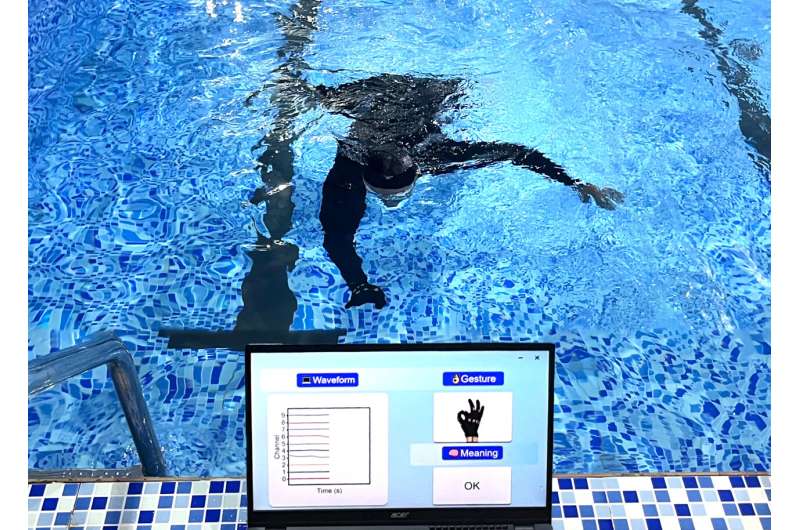
When scuba divers need to say "I'm okay" or "Shark!" to their dive partners, they use hand signals to communicate visually. But sometimes these movements are difficult to see.
Now, researchers reporting in ACS Nano have constructed a waterproof "e-glove" that wirelessly transmits hand gestures made underwater to a computer that translates them into messages. The new technology could someday help divers communicate better with each other and with boat crews on the surface.
E-gloves—gloves fitted with electronic sensors that translate hand motions into information—are already in development, including designs that allow the wearer to interact with virtual reality environments or help people recovering from a stroke regain fine motor skills. However, rendering the electronic sensors waterproof for use in a swimming pool or the ocean, while also keeping the glove flexible and comfortable to wear, is a challenge.
So Fuxing Chen, Lijun Qu, Mingwei Tian and colleagues wanted to create an e-glove capable of sensing hand motions when submerged underwater.
The researchers began by fabricating waterproof sensors that rely on flexible microscopic pillars inspired by the tube-like feet of a starfish. Using laser writing tools, they created an array of these micropillars on a thin film of polydimethylsiloxane (PDMS), a waterproof plastic commonly used in contact lenses.
After coating the PDMS array with conductive layer of silver, the researchers sandwiched two of the films together with the pillars facing inward to create a waterproof sensor.
The sensor—roughly the size of a USB-C port—is responsive when flexed and can detect a range of pressures comparable to the light touch of a dollar bill up to the impact of water streaming from a garden hose. The researchers packaged 10 of these waterproof sensors within self-adhesive bandages and sewed them over the knuckles and first finger joints of their e-glove prototype.
To create a hand-gesture vocabulary for the researchers' demonstration, a participant wearing the e-glove made 16 gestures, including "OK" and "Exit." The researchers recorded the specific electronic signals generated by the e-glove sensors for each corresponding gesture.
They applied a machine learning technique for translating sign language into words to create a computer program that could translate the e-glove gestures into messages.
When tested, the program translated hand gestures made on land and underwater with 99.8% accuracy. In the future, the team says a version of this e-glove could help scuba divers communicate with visual hand signals even when they cannot clearly see their dive partners.
More information: Underwater Gesture Recognition Meta-Gloves for Marine Immersive Communication, ACS Nano (2024). DOI: 10.1021/acsnano.3c13221
Citation: Waterproof 'e-glove' could help scuba divers communicate (2024, April 10) retrieved 10 April 2024 from https://techxplore.com/news/2024-04-waterproof-glove-scuba-divers-communicate.html
This document is subject to copyright. Apart from any fair dealing for the purpose of private study or research, no part may be reproduced without the written permission. The content is provided for information purposes only.
